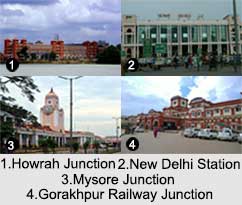 Indian Railway stations have one of the largest and busiest rail networks in the world. The British rulers introduced rail services in India in 1851 and since then, the Indian Railways (IR) have significantly increased its rail network. The IR has established railway stations in almost every corner of the country and has been working relentlessly for connecting all the remote places of India to the major cities. The total number of Indian Railway stations is thought to be near about 8,000.
Indian Railway stations have one of the largest and busiest rail networks in the world. The British rulers introduced rail services in India in 1851 and since then, the Indian Railways (IR) have significantly increased its rail network. The IR has established railway stations in almost every corner of the country and has been working relentlessly for connecting all the remote places of India to the major cities. The total number of Indian Railway stations is thought to be near about 8,000.
History of Indian Railways
The Indian Railway has completed 150 years of its glorious journey and is increasing its reach day by day. Indian Railway inaugurated its passenger train service in 1853, when a train was run between Bori Bunder Bombay and Thane. The first passenger train in the Eastern region of India ran between Howrah and Hooghly in West Bengal, on 15th August, 1854. After that, Indian Railways started spreading its network throughout the country and several stations were also established. There were 42 different rail systems in India till 1947 and all the systems were nationalised as one unit in 1951. At present, Indian Railway has divided its operations in 16 zones.
Famous Indian Railway Stations
 There are many Indian Railway stations established only for passing local trains and the long-distance trains. There are separate stations for the long distance trains as well. Apart from the stations, there are some halts in remote places where only a few trains stop. About 14,000 trains run through the Indian Railway stations regularly. Following are the famous Indian Railway Stations:
There are many Indian Railway stations established only for passing local trains and the long-distance trains. There are separate stations for the long distance trains as well. Apart from the stations, there are some halts in remote places where only a few trains stop. About 14,000 trains run through the Indian Railway stations regularly. Following are the famous Indian Railway Stations:
Howrah Junction: It is the busiest railway station and its 23 platforms are serving more than a million passengers. It also has the largest number of railway platforms in India and one of the busiest railway platforms also.
New Delhi Station: It is the second busiest and largest railway station in India. It manages over 350 trains and 500,000 passengers on every day with 16 platforms and also holds the record for the largest road interlocking system in the world.
Kanpur Central: It is one of the busiest stations of the North Central Railways with more than 280 trains per day. It also holds the record for the largest interlocking route system in the world along with Delhi station and one of five Central railway stations in India.
Vijayawada Station: It has more than 400 freight and passenger trains. It is categorized as a premium station in India and also one of the ten model stations in the Vijayawada allotment.
Trivandrum Railway Station: It is the largest and busiest railway station in Kerala. Thiruvananthapuram is the first major city in south India with longest train routes in India.
 Chhatrapati Shivaji Railway Station: It is listed as India"s one of the best railway stations. It is a historic railway station and a UNESCO World Heritage Site in Mumbai. The station`s name was changed from Victoria Terminus to Chhatrapati Shivaji Terminus in March 1996 in honour of Emperor Chhatrapati Shivaji.
Chhatrapati Shivaji Railway Station: It is listed as India"s one of the best railway stations. It is a historic railway station and a UNESCO World Heritage Site in Mumbai. The station`s name was changed from Victoria Terminus to Chhatrapati Shivaji Terminus in March 1996 in honour of Emperor Chhatrapati Shivaji.
Mysore Junction: It is a home of "Model Railroad Layout", which is the first of its type in the country. It also has models of Chamundi Hill, Clock Tower, church and Zoo.
Varanasi Junction: It is one of the busiest and significant railway stations in India. It is the highest profit generating station of Indian Railways.
Gorakhpur Railway Junction: It has the world"s longest Railway platform that extends around 1.35 kilometres and a very important junction of Northern Indian railways.
Cuttack Railway Station: It is amongst the top hundred daily booking stations of Indian Railway. The architecture of Cuttack Railway Station has motivated many architects around the world.
Dudhsagar Railway Station: It is situated at the border of Goa and Karnataka near the Dudhsagar waterfall. The part of Dudhsagar Railway Station and Castle rock railway station is surrounded by a forest.
Ghum Railway Station: It is the highest railway station in India, on the route of the Darjeeling Himalayan Railway. The place is one of the top five highest mountain railway stations of India.
Srinagar Railway Station: It is a part of the Kashmir Railway. It features the Kashmiri wood architecture and is designed to match the local surroundings.
Mughalsarai Railway Station: It is the fourth busiest railway junction in India and has a huge railway yard which is the largest railway marshalling yard in Asia.
Charbagh Railway Station: It is one of the busiest railway stations of India with more than 300 trains passing from the station. Lucknow Charbagh railway station is famous for architectural masterwork and is ranked as one of the most beautiful railway stations in India.
Other famous railway stations of India are Nagpur Railway Station, Kharagpur Junction, Jaisalmer Railway Station, Sealdah Railway Station, Bilaspur Railway Station, Agartala Main Station, Chennai Egmore Railway Station, Kanyakumari Railway Station etc.















